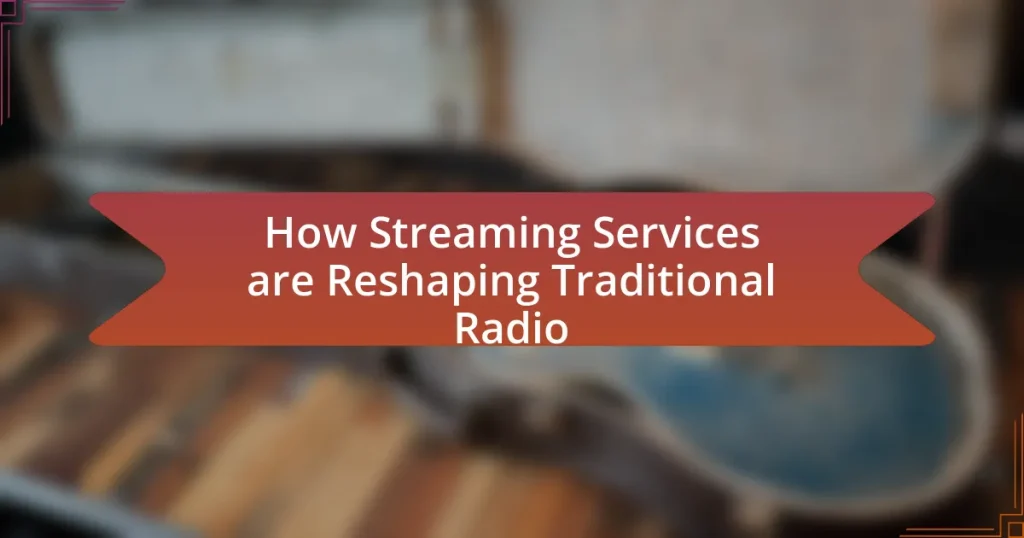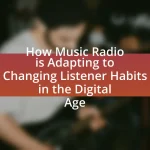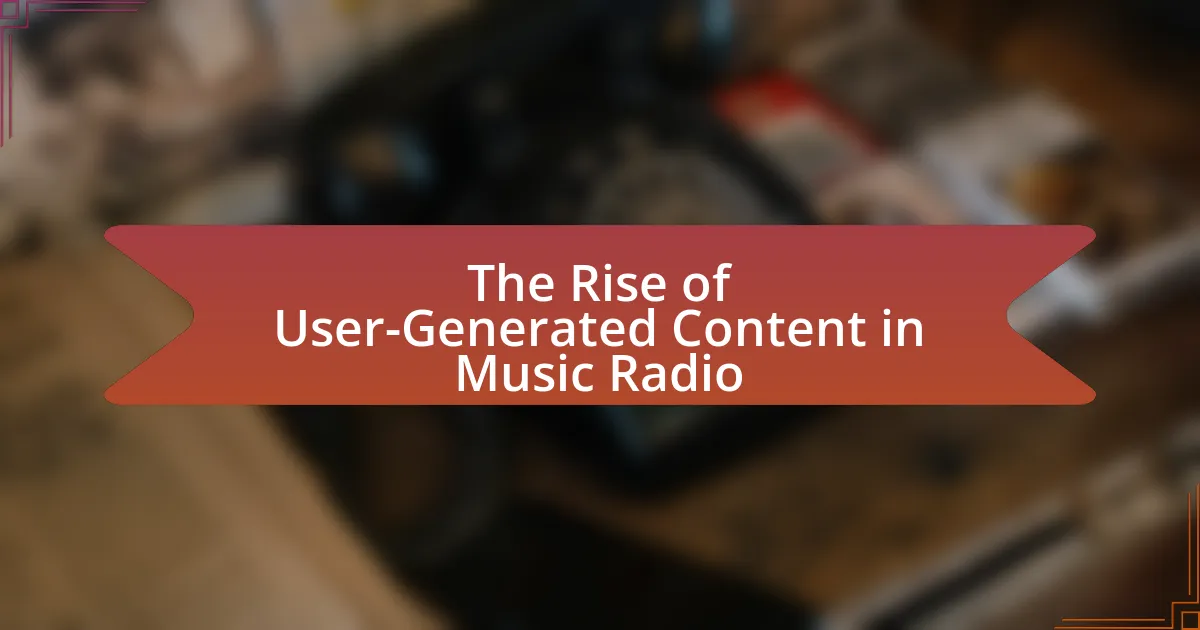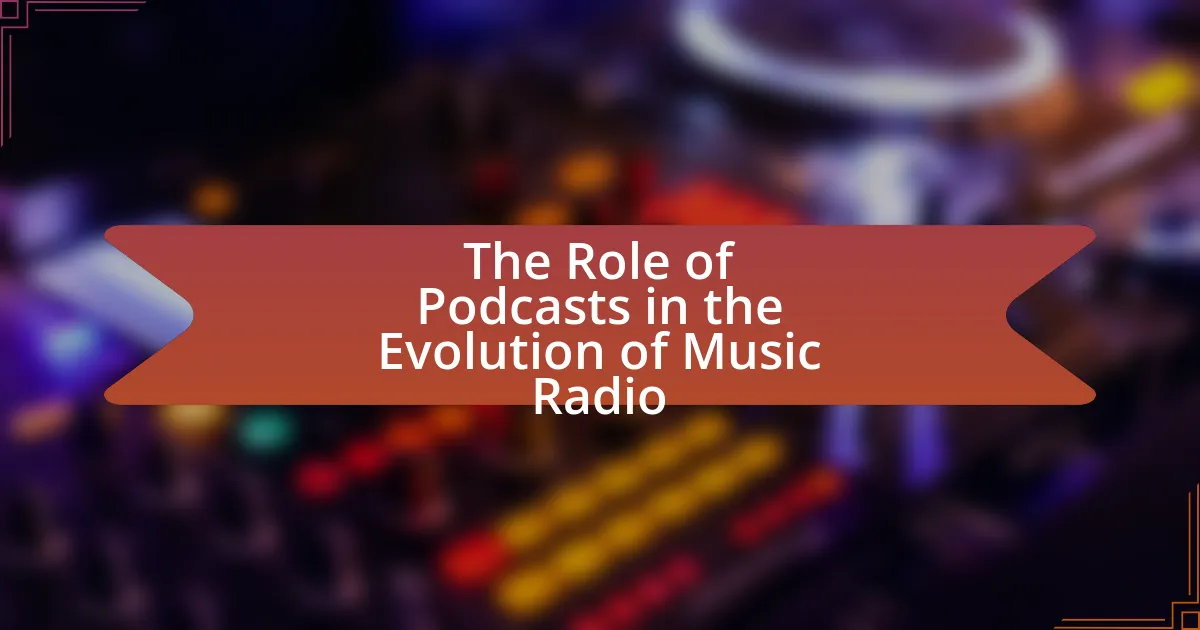Streaming services are fundamentally reshaping traditional radio by offering on-demand access to a diverse range of audio content, which traditional radio cannot match due to its fixed schedules and limited playlists. The article examines key differences between streaming platforms and traditional radio, highlighting the decline in radio listenership as more consumers, particularly younger audiences, gravitate towards personalized and flexible listening experiences. It discusses the implications of on-demand listening for traditional radio, including challenges in audience retention and advertising revenue, and explores how technological innovations and social media integration are influencing both mediums. Additionally, the article outlines potential future trends, including hybrid models that combine elements of both streaming and traditional radio, as well as practical steps traditional radio stations can take to adapt to the evolving audio landscape.

How are Streaming Services Changing the Landscape of Traditional Radio?
Streaming services are significantly altering the landscape of traditional radio by providing on-demand access to a vast array of audio content, which traditional radio cannot match. Unlike traditional radio, which operates on fixed schedules and limited playlists, streaming platforms like Spotify and Apple Music allow users to curate their own listening experiences, leading to a decline in traditional radio listenership. According to a 2021 report by Edison Research, 68% of Americans aged 12 and older listen to online audio weekly, compared to 57% for AM/FM radio, indicating a shift in consumer preferences. This transition is further evidenced by the rise of podcasting, which has become a dominant form of audio entertainment, attracting audiences that traditional radio struggles to reach.
What are the key differences between streaming services and traditional radio?
Streaming services differ from traditional radio primarily in their delivery method and user control. Streaming services provide on-demand access to a vast library of audio content, allowing users to choose what they listen to and when, while traditional radio broadcasts content at scheduled times, limiting listener choice. Additionally, streaming services often utilize algorithms to personalize recommendations based on user preferences, whereas traditional radio relies on pre-programmed playlists and live DJs. According to a 2021 report by the Pew Research Center, 61% of Americans aged 18-29 prefer streaming services over traditional radio, highlighting a significant shift in listening habits.
How do content delivery methods differ between streaming services and traditional radio?
Content delivery methods differ significantly between streaming services and traditional radio. Streaming services deliver content on-demand via the internet, allowing users to select specific songs, albums, or playlists at their convenience, while traditional radio broadcasts content in real-time over airwaves, requiring listeners to tune in at scheduled times. For example, platforms like Spotify and Apple Music enable users to create personalized playlists and access vast libraries of music, whereas traditional radio stations play a predetermined selection of songs and programs, often with limited listener interaction. This fundamental difference in delivery method reflects the shift in consumer preferences towards personalized and flexible listening experiences.
What are the implications of on-demand listening for traditional radio?
On-demand listening significantly undermines traditional radio’s audience retention and advertising revenue. As listeners increasingly prefer the flexibility of streaming services, traditional radio stations face declining listener numbers, which directly impacts their ability to attract advertisers. According to a 2021 Nielsen report, 62% of Americans aged 18-34 prefer on-demand audio, indicating a shift in consumer behavior that traditional radio struggles to adapt to. This trend forces traditional radio to reconsider its programming strategies, potentially leading to a focus on niche content or live events to differentiate itself from the convenience of on-demand platforms.
Why are listeners gravitating towards streaming services over traditional radio?
Listeners are gravitating towards streaming services over traditional radio primarily due to the convenience and personalization that streaming platforms offer. Streaming services allow users to access a vast library of music and podcasts on-demand, enabling them to create customized playlists and discover new content tailored to their preferences. According to a 2021 report by the Recording Industry Association of America, streaming accounted for 83% of the U.S. music industry’s revenue, highlighting the significant shift in consumer behavior towards these platforms. Additionally, streaming services often provide ad-free experiences and offline listening options, further enhancing user satisfaction compared to traditional radio, which is limited by scheduled programming and advertisements.
What factors contribute to the popularity of streaming services among younger audiences?
The popularity of streaming services among younger audiences is primarily driven by convenience, diverse content offerings, and affordability. Younger audiences prefer the ability to access a wide range of media anytime and anywhere, facilitated by mobile devices and high-speed internet. According to a 2021 survey by Deloitte, 70% of Gen Z and Millennials reported that they value the flexibility of streaming services, allowing them to watch or listen to content on their own schedule. Additionally, streaming platforms often provide exclusive content and original programming that appeals to younger demographics, further enhancing their attractiveness. The cost-effectiveness of subscription models, compared to traditional cable or radio, also plays a significant role, as many younger consumers prioritize budget-friendly entertainment options.
How does personalization in streaming services enhance user experience compared to traditional radio?
Personalization in streaming services significantly enhances user experience compared to traditional radio by providing tailored content that aligns with individual preferences. Streaming platforms utilize algorithms to analyze user behavior, such as listening history and song ratings, allowing them to curate playlists and recommend music that resonates with each listener. In contrast, traditional radio offers a one-size-fits-all approach, where listeners have no control over the content being played, leading to a less engaging experience. Research indicates that 70% of users prefer personalized recommendations, highlighting the effectiveness of this approach in increasing user satisfaction and engagement.
What challenges are traditional radio stations facing due to the rise of streaming services?
Traditional radio stations are facing significant challenges due to the rise of streaming services, primarily in audience retention and advertising revenue. Streaming platforms like Spotify and Apple Music offer personalized content and on-demand access, which attract listeners away from traditional radio. According to a 2021 report by Nielsen, over 50% of U.S. adults listen to streaming audio weekly, highlighting a shift in listener preferences. Additionally, advertising revenue for traditional radio has declined, with eMarketer reporting a drop of nearly 20% from 2019 to 2021, as advertisers increasingly allocate budgets to digital platforms that provide targeted advertising capabilities. These factors contribute to the ongoing struggle of traditional radio stations to maintain their relevance in a rapidly evolving media landscape.
How are advertising models changing in response to streaming services?
Advertising models are evolving to incorporate targeted and data-driven strategies in response to the rise of streaming services. Traditional advertising methods, which relied heavily on broad demographics, are being replaced by personalized ads that leverage user data and viewing habits. For instance, streaming platforms like Hulu and Spotify utilize algorithms to deliver tailored advertisements based on individual user preferences, resulting in higher engagement rates. According to a report by eMarketer, digital ad spending in the U.S. is projected to surpass $200 billion in 2023, highlighting the shift towards more effective, measurable advertising approaches that streaming services facilitate.
What strategies are traditional radio stations employing to compete with streaming services?
Traditional radio stations are employing several strategies to compete with streaming services, including enhancing local content, leveraging live events, and integrating digital platforms. By focusing on local news, music, and community engagement, radio stations differentiate themselves from the global reach of streaming services. Additionally, many stations are hosting live events and concerts to foster listener loyalty and create unique experiences that streaming platforms cannot replicate. Furthermore, traditional radio is increasingly utilizing digital platforms, such as mobile apps and social media, to reach younger audiences and provide on-demand content, thereby expanding their listener base and adapting to changing consumer preferences. These strategies are essential for maintaining relevance in an evolving media landscape where streaming services dominate.
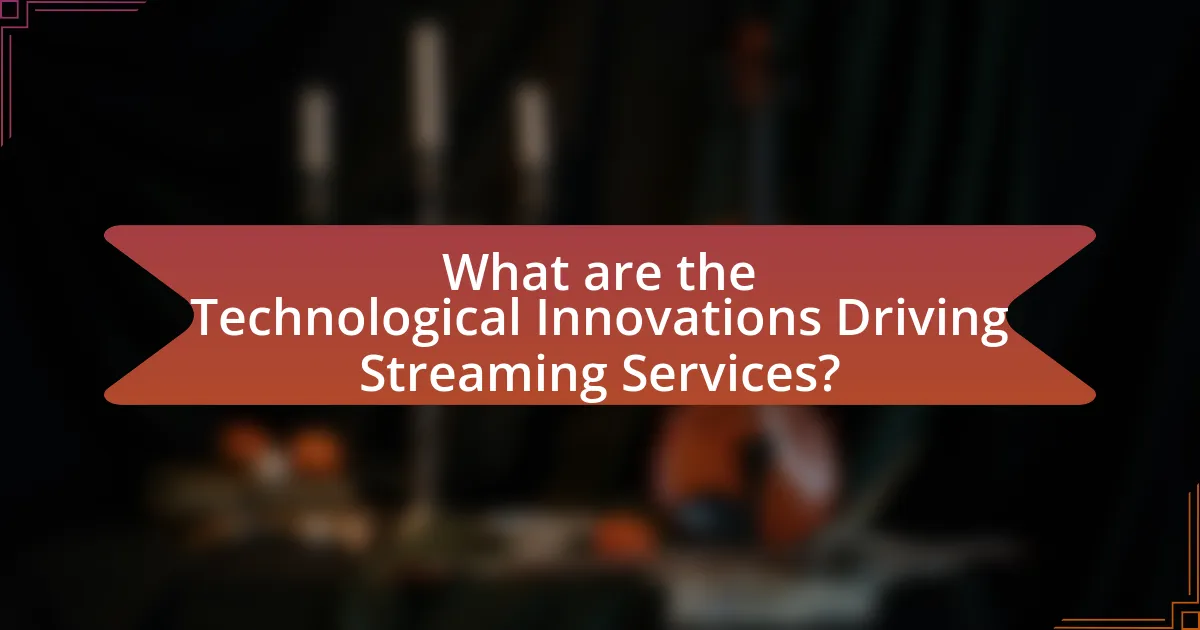
What are the Technological Innovations Driving Streaming Services?
Technological innovations driving streaming services include advancements in cloud computing, artificial intelligence, and adaptive bitrate streaming. Cloud computing enables scalable storage and processing power, allowing services to deliver vast libraries of content efficiently. Artificial intelligence enhances user experience through personalized recommendations and content curation, improving engagement and retention rates. Adaptive bitrate streaming optimizes video and audio quality based on users’ internet speeds, ensuring seamless playback. These innovations collectively enhance the accessibility, quality, and personalization of streaming services, significantly impacting how traditional radio is consumed.
How has technology enabled the growth of streaming services?
Technology has enabled the growth of streaming services by providing high-speed internet access, advanced data compression techniques, and powerful cloud computing resources. High-speed internet allows users to stream content seamlessly without buffering, while data compression techniques reduce the bandwidth required for streaming, making it accessible to a broader audience. Additionally, cloud computing supports the storage and distribution of vast libraries of content, enabling services like Spotify and Netflix to offer extensive catalogs to users. According to a report by Statista, the global number of streaming subscribers reached over 1 billion in 2021, highlighting the significant impact of these technological advancements on the industry’s growth.
What role do mobile applications play in the accessibility of streaming services?
Mobile applications significantly enhance the accessibility of streaming services by allowing users to access content anytime and anywhere on their devices. These applications provide a user-friendly interface that simplifies navigation and content discovery, making it easier for individuals to find and enjoy their preferred audio and video content. According to a report by Statista, as of 2023, over 80% of streaming service users access platforms through mobile apps, highlighting their critical role in expanding user reach and engagement.
How has internet bandwidth improvement impacted streaming quality?
Internet bandwidth improvement has significantly enhanced streaming quality by allowing higher data transfer rates, which facilitates the delivery of high-definition audio and video content. As bandwidth has increased, streaming services can now offer 4K video resolution and lossless audio formats, resulting in a more immersive user experience. For instance, a study by the Federal Communications Commission (FCC) reported that average broadband speeds in the U.S. increased from 25 Mbps in 2015 to over 100 Mbps in 2020, enabling smoother playback and reducing buffering times. This advancement directly correlates with the ability of streaming platforms to provide superior quality content, thereby reshaping user expectations and consumption patterns in the digital media landscape.
What advancements in data analytics are influencing streaming service offerings?
Advancements in data analytics, such as machine learning algorithms and real-time user behavior tracking, are significantly influencing streaming service offerings. These technologies enable streaming platforms to analyze vast amounts of user data, allowing for personalized content recommendations and targeted advertising. For instance, Netflix employs sophisticated algorithms that analyze viewing patterns to suggest shows and movies tailored to individual preferences, resulting in increased user engagement and retention. Additionally, real-time analytics help services like Spotify to adapt playlists based on current trends and user interactions, enhancing the overall listening experience.
How do streaming services utilize user data to enhance content recommendations?
Streaming services utilize user data to enhance content recommendations by analyzing viewing habits, preferences, and interactions. These platforms collect data such as watch history, search queries, and user ratings to create personalized algorithms that suggest content tailored to individual tastes. For instance, Netflix employs a recommendation system that accounts for over 80% of the content watched on its platform, demonstrating the effectiveness of data-driven personalization. By leveraging machine learning techniques, streaming services continuously refine their recommendations based on real-time user engagement, ensuring that the content remains relevant and engaging for each user.
What technologies are being used to improve audio quality in streaming services?
Streaming services are utilizing technologies such as Advanced Audio Coding (AAC), Dolby Atmos, and lossless audio formats to enhance audio quality. AAC is widely adopted for its efficient compression while maintaining sound fidelity, allowing for high-quality streaming even at lower bitrates. Dolby Atmos provides an immersive audio experience by enabling spatial sound, which enhances the listener’s perception of audio depth and directionality. Additionally, lossless audio formats like FLAC and ALAC deliver uncompressed sound, preserving the original recording quality, which appeals to audiophiles. These technologies collectively contribute to a superior listening experience, making streaming services competitive with traditional radio.
How are social media platforms integrating with streaming services?
Social media platforms are integrating with streaming services by enabling content sharing, live interactions, and collaborative features. For instance, platforms like Facebook and Instagram allow users to share live streams from services such as Twitch and YouTube, enhancing viewer engagement through comments and reactions in real-time. Additionally, TikTok has partnered with various music streaming services to allow users to create short videos using licensed music, which drives traffic to those streaming platforms. This integration not only boosts user interaction but also increases visibility and reach for both social media and streaming services, as evidenced by the rise in user-generated content that promotes streaming platforms.
What benefits do streaming services gain from social media partnerships?
Streaming services gain increased audience engagement and brand visibility from social media partnerships. By collaborating with social media platforms, streaming services can leverage user-generated content, targeted advertising, and influencer marketing to reach wider audiences. For instance, a study by Nielsen found that social media campaigns can increase viewership by up to 30%, demonstrating the effectiveness of these partnerships in driving user interaction and subscription growth. Additionally, streaming services can utilize social media analytics to better understand viewer preferences, allowing for more tailored content offerings.
How do social media trends influence the content available on streaming platforms?
Social media trends significantly influence the content available on streaming platforms by shaping viewer preferences and driving content discovery. For instance, viral challenges or popular memes on platforms like TikTok often lead to increased demand for specific songs, prompting streaming services to feature these tracks prominently in playlists or recommendations. A study by Nielsen found that 67% of consumers are more likely to listen to a song after seeing it on social media, demonstrating the direct correlation between social media engagement and streaming content popularity. Consequently, streaming platforms adapt their offerings to align with these trends, ensuring they remain relevant and appealing to their audience.
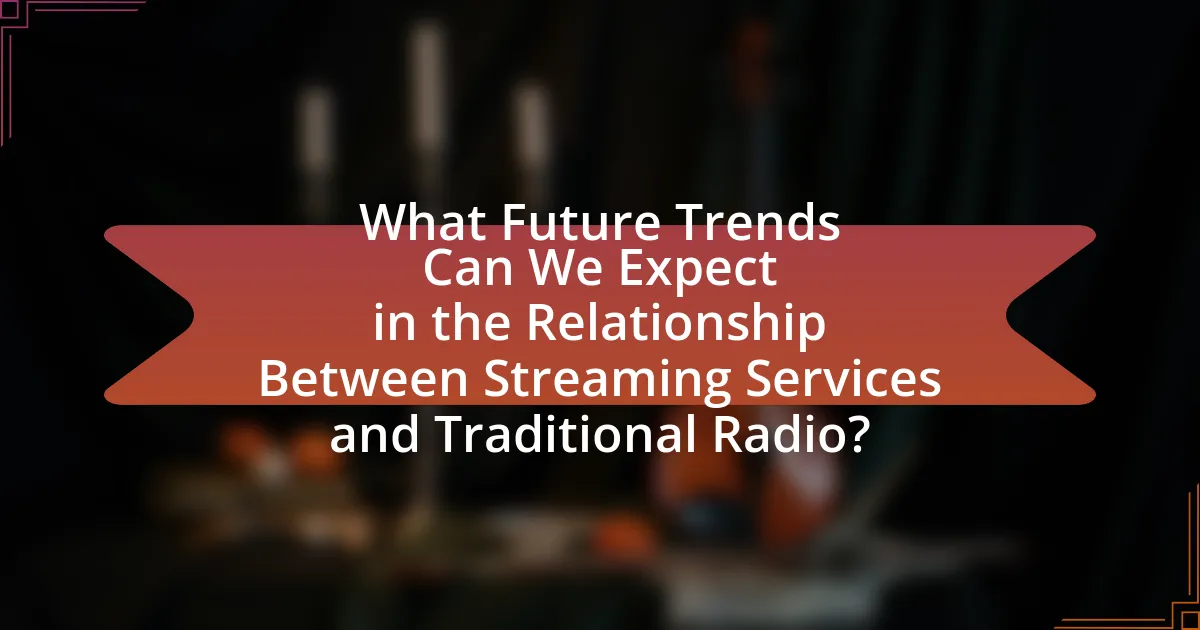
What Future Trends Can We Expect in the Relationship Between Streaming Services and Traditional Radio?
The relationship between streaming services and traditional radio is expected to evolve towards increased integration and collaboration. As streaming platforms continue to gain popularity, traditional radio stations are likely to adopt hybrid models that incorporate streaming technology, allowing them to reach broader audiences and provide on-demand content. For instance, a report from the Edison Research “The Infinite Dial 2023” indicates that over 60% of Americans aged 12 and older now listen to online audio, highlighting the growing trend of digital consumption. This shift will likely lead to traditional radio enhancing their digital presence through apps and partnerships with streaming services, ultimately creating a more versatile audio landscape that caters to diverse listener preferences.
How might traditional radio evolve in response to streaming services?
Traditional radio may evolve by integrating digital platforms and enhancing interactivity to compete with streaming services. As streaming services offer personalized content and on-demand access, traditional radio stations are likely to adopt similar features, such as mobile apps and online streaming, to reach a broader audience. For instance, according to a 2021 Nielsen report, over 50% of radio listeners also use streaming services, indicating a shift in listener preferences. This data suggests that traditional radio must innovate by incorporating listener feedback and creating tailored programming to retain and attract audiences.
What hybrid models are emerging that combine elements of both streaming and traditional radio?
Emerging hybrid models that combine elements of both streaming and traditional radio include internet radio stations that offer live broadcasts alongside on-demand content, as well as platforms like Spotify and Apple Music that integrate curated playlists with live DJ shows. These models leverage the accessibility of streaming technology while maintaining the live interaction and programming style characteristic of traditional radio. For instance, services like iHeartRadio provide live radio streaming with the option to listen to past shows on-demand, effectively merging the two formats. This integration reflects a growing trend where listeners seek both the immediacy of live broadcasts and the flexibility of streaming services.
How can traditional radio leverage streaming technology to enhance its offerings?
Traditional radio can leverage streaming technology by integrating online platforms to reach a broader audience and provide on-demand content. This integration allows radio stations to offer live streaming of broadcasts, enabling listeners to tune in from anywhere, thus expanding their listener base beyond geographical limitations. Additionally, traditional radio can enhance its offerings by creating podcasts and on-demand shows, which cater to the preferences of modern listeners who favor flexibility in content consumption. According to a 2021 report by Edison Research, 41% of Americans aged 12 and older listen to podcasts monthly, indicating a significant opportunity for traditional radio to engage with this growing audience through streaming.
What role will emerging technologies play in shaping the future of audio consumption?
Emerging technologies will significantly enhance audio consumption by enabling personalized experiences and improving accessibility. Innovations such as artificial intelligence and machine learning allow streaming services to analyze user preferences, leading to tailored content recommendations that increase listener engagement. For instance, Spotify’s algorithm curates playlists based on individual listening habits, which has contributed to its growth, with over 400 million users as of 2023. Additionally, advancements in voice recognition technology facilitate hands-free interaction with audio platforms, making it easier for users to access content. This shift towards personalized and accessible audio experiences is reshaping traditional radio by attracting audiences who prefer on-demand listening over scheduled broadcasts.
How might artificial intelligence impact content creation in both streaming and traditional radio?
Artificial intelligence will significantly enhance content creation in both streaming and traditional radio by automating processes and personalizing user experiences. AI algorithms can analyze listener preferences and behaviors, enabling platforms to curate tailored playlists and suggest relevant content, which increases listener engagement. For instance, Spotify uses AI-driven recommendation systems that analyze user data to create personalized playlists, resulting in a reported 40% increase in user engagement. In traditional radio, AI can assist in generating scripts, optimizing scheduling, and even creating music, thereby streamlining production and reducing costs. The integration of AI in these mediums not only improves efficiency but also allows for a more dynamic and responsive content creation process.
What potential does virtual reality hold for the future of audio experiences?
Virtual reality holds significant potential for transforming audio experiences by creating immersive soundscapes that enhance user engagement. This technology allows for spatial audio, where sound can be perceived from multiple directions, mimicking real-world acoustics. Research indicates that immersive audio experiences can increase listener retention and emotional connection, as demonstrated in studies showing that users in virtual environments report higher satisfaction levels compared to traditional audio formats. Furthermore, VR can facilitate interactive audio experiences, enabling users to influence sound elements in real-time, thereby personalizing their listening experience. This shift aligns with the evolving landscape of streaming services, which are increasingly integrating advanced audio technologies to attract and retain audiences.
What practical steps can traditional radio stations take to adapt to the streaming era?
Traditional radio stations can adapt to the streaming era by developing their own online streaming platforms and enhancing their digital presence. By creating dedicated apps or websites for streaming, radio stations can reach a broader audience beyond their geographical limitations. Additionally, they should invest in social media marketing to engage listeners and promote their content, as 54% of consumers prefer to discover new music through social media platforms. Furthermore, incorporating on-demand content, such as podcasts and recorded shows, allows listeners to access programming at their convenience, aligning with the growing trend of personalized media consumption. Lastly, collaborating with popular streaming services can help traditional stations tap into existing listener bases and leverage technology for better audience analytics.
How can traditional radio enhance listener engagement through digital platforms?
Traditional radio can enhance listener engagement through digital platforms by integrating interactive features such as live streaming, social media interaction, and on-demand content. These digital tools allow listeners to participate in real-time discussions, request songs, and provide feedback, fostering a sense of community and connection. For instance, a study by the Pew Research Center found that 49% of Americans engage with radio stations via social media, indicating that digital platforms significantly increase listener interaction and loyalty. By leveraging these platforms, traditional radio can create a more immersive and engaging experience for its audience.
What best practices should traditional radio adopt to remain relevant in a streaming-dominated market?
Traditional radio should adopt a multi-platform approach to remain relevant in a streaming-dominated market. This includes integrating digital streaming options, enhancing social media engagement, and creating on-demand content to meet listener preferences. For instance, according to a Nielsen report, 62% of Americans listen to online radio, indicating a significant shift towards digital platforms. By leveraging these trends, traditional radio can attract and retain audiences who prefer the flexibility and accessibility offered by streaming services.
